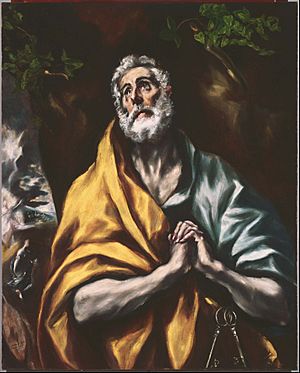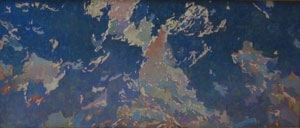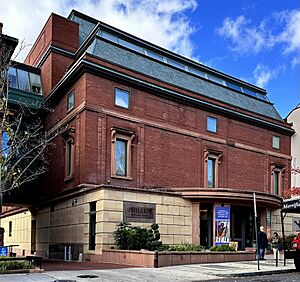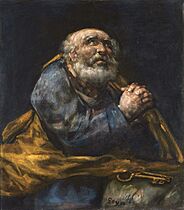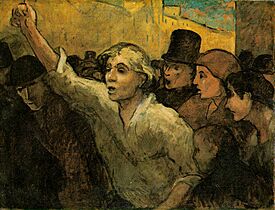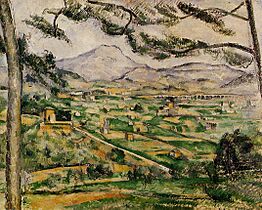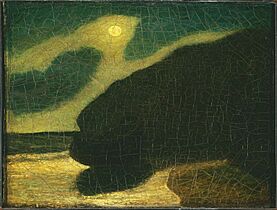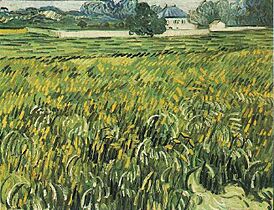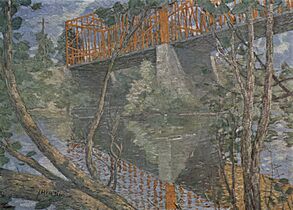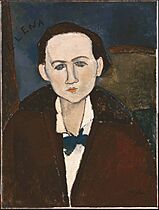The Phillips Collection facts for kids

The Phillips Collection building in Dupont Circle
|
|
| Established | 1921 |
|---|---|
| Location | 1600 21st Street NW Washington, D.C. |
| Type | Art museum |
| Public transit access | |
The Phillips Collection is a famous art museum located in the Dupont Circle area of Washington, D.C.. It was started in 1921 by art lovers Duncan Phillips and Marjorie Acker Phillips. They first called it the Phillips Memorial Gallery. Duncan Phillips was the grandson of a banker named James H. Laughlin.
The museum has many amazing artworks by artists like Pierre-Auguste Renoir, Vincent van Gogh, Henri Matisse, Pablo Picasso, Georgia O'Keeffe, and Mark Rothko.
Contents
History of the Phillips Collection
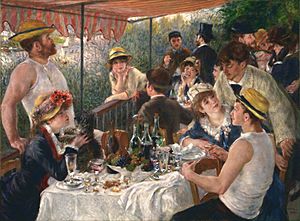
Duncan Phillips (1886–1966) was very important in bringing modern art to America. He was born in Pittsburgh and moved to Washington, D.C., in 1895. Duncan and his mother started The Phillips Memorial Gallery after his brother and father passed away.
They began with a small collection of family paintings. Duncan Phillips, who was also an art critic, quickly made the collection much bigger. They even built a special room in their family home for people to see the art. By 1930, the collection had over 600 artworks. The Phillips family then moved to a new home, and their entire 21st Street house became an art museum.
In 1921, Duncan Phillips married a painter named Marjorie Acker. With her help, Phillips wanted his collection to be "a museum of modern art and its sources." He believed that artists throughout history influenced each other. This idea was new because many people in America at the time thought modernism was a complete break from the past. Phillips collected works by old masters like El Greco and Jean-Baptiste-Siméon Chardin, seeing them as early examples of modern ideas.
Polly Fritchey, a family friend, also helped the Phillips Collection grow from a small family museum into a public art gallery. She was one of the first people from outside the family to join the museum's board.
The Art Collection
The Phillips Collection opened its doors in 1921. It has a permanent collection of almost 3,000 artworks by American and European impressionist and modern artists. The museum is known for its art and its cozy, welcoming feeling. It is located in Duncan Phillips’s old 1897 Georgian Revival home and two newer additions in Washington, D.C.’s Dupont Circle neighborhood.
The museum is famous for its wide range of impressionist and modern paintings. You can see works by European masters such as Gustave Courbet, Pierre Bonnard, Paul Cézanne, Vincent van Gogh, Henri Matisse, Claude Monet, and Pablo Picasso. In 1923, Phillips bought Pierre-Auguste Renoir's impressionist painting, Luncheon of the Boating Party (1880–81), which is the museum’s most well-known artwork.
From the 1920s to the 1960s, Phillips arranged his galleries in a special way. He didn't just put paintings in order by date. Instead, he grouped them to show how different artworks and artists connected. He wanted to create "dialogues" between past and present art, and between classical and expressive styles. He showed works by American artists like Winslow Homer and Georgia O'Keeffe alongside European artists like Cézanne and van Gogh. This unique way of displaying art still guides the museum today.
The Phillips Collection also has many works by artists that Phillips especially liked. For example, he loved Bonnard's use of color and bought 17 of his paintings. He also collected many works by Georges Braque, Paul Klee, and Mark Rothko.
The Rothko Room is a special place in the museum. It was the first public room made just for the artist Mark Rothko's work. Phillips designed it with Rothko's ideas in mind, making it a small, quiet space filled with color. This room is the only one like it that Rothko helped design himself.
Duncan Phillips also bought paintings from many artists who were not yet famous, like John Marin, Georgia O'Keeffe, and Arthur Dove. By buying their art, Phillips helped these promising artists continue their work. He even became close friends with some of them and supported them financially. The museum also became a favorite place for artists like Richard Diebenkorn and Kenneth Noland to visit and find inspiration.
In 2013, the museum opened another special room with a wax artwork by artist Wolfgang Laib. This piece is 6 feet by 7 feet and is lit by a single light bulb. Laib was inspired to create it after seeing the Rothko Room.
The Museum Building
The Phillips Collection is located in a unique building in Washington's Dupont Circle neighborhood. When Duncan Phillips first started the museum, he showed his art in special galleries within his own home. This home, a Georgian Revival house built in 1897, is now the southern part of the museum. The northern part is called the Goh Annex.
Over time, the building was changed to add more galleries and offices, especially after the Phillips family moved out in 1930. In 1960, Phillips added a modern section. This part was updated again in 1989 with help from a Japanese businessman, Yasuhiro Goh, and his wife. This updated section is known as the Goh Annex.
Updates and New Spaces
To make room for its growing art collection and more visitors, the Phillips Collection finished a big building project in April 2006. Most of the new space was built underground. This helped keep the museum's cozy, home-like feel and fit in with the neighborhood. The new areas, called the Sant Building, include bigger galleries for larger artworks, an auditorium for talks and films, an outdoor courtyard, and a new shop and café.
The 2006 expansion also created The Phillips Collection Center for the Study of Modern Art. This center brought together experts to discuss and research modern art. The building for this center, which used to be a carriage house, now hosts programs and classes about modern and contemporary art.
In 2015, the Phillips Collection started working with The University of Maryland. The center was renamed "The University of Maryland Center for Art and Knowledge at The Phillips Collection." This partnership helps create new art courses, research programs, and events.
Museum Café
The museum has a café called Bread Furst. It's an artisanal bakery that also serves drinks and other tasty treats.
Museum Activities and Programs
The Phillips Collection offers many educational services and live programs for visitors. They work with local schools and other groups.
Learning at the Museum
From the museum's early days, teaching about art has been important. Today, the museum has many lectures, gallery talks, classes, and workshops for families and teachers. They also have programs like Art Links to Literacy, which helps students and parents from District of Columbia Public Schools. The museum has new spaces for student art, a hands-on art activity room, and a technology lab for creating interactive learning tools.
Fun Programs and Events
- Phillips After 5 is a monthly event on the first Thursday evening. It features live jazz music, talks about the art, and a place to buy drinks.
- Sunday Concerts, started in 1941, offer classical chamber music in the museum's Music Room. These concerts feature famous musicians and talented young artists. They happen from October through May.
- Live music performances by local and international musicians are often held in the museum. These include special events like the yearly New Year Celebration.
- Centennial music commissions are projects where composers create music inspired by artworks in the collection. You can find these audiovisual works on the Phillips Collection website.
- In 2009, an event called "Art Is _____" invited visitors to share their own definitions of art using text messages.
- In 2021, the museum hosted an exhibition called Inside Outside, Upside Down, which showed art by 64 D.C.-area artists.
- Artwalks happen on the third Thursday of every month. A curator or special guest walks with visitors through the galleries, talking about the artists and the stories behind the artworks.
- Meditation is a free weekly wellness activity led by a yoga teacher. It's a 30-minute program that helps people relax and cope with stress. It's offered online through Zoom.
- 360-Degree tours are virtual tours of the museum's exhibitions. They include full-screen images, descriptions of the art, and audio guides.
Museum Directors
When Duncan Phillips passed away in 1966, his wife Marjorie became the museum director. Their son, Laughlin, took over in 1972. He worked to make sure the museum's art and finances were secure, improved the buildings, and made the museum more open to the public.
Later directors included Charles S. Moffett (1992–1998), Jay Gates (1998–2008), and Dorothy M. Kosinski (2008–2023). In 2023, Jonathan Binstock became the new director.
List of Directors
- Jonathan P. Binstock (2023-present)
- Dorothy M. Kosinski (2008–2023)
- Jay Gates (1998–2008)
- Charles Moffett (1992–1998)
- Laughlin Phillips (1972–1992)
- Marjorie Acker (1966–1972)
- Duncan Phillips (1921–1966)
Selected highlights
-
Francisco Goya, St. Peter Repentant, 1823-1825
-
Eugène Delacroix, Portrait of Paganini, 1832
-
Honoré Daumier, The Uprising, 1848
-
Paul Cézanne, Mont Sainte-Victoire with Large Pine, 1886-1887
-
Paul Gauguin, The Ham, 1889
-
Vincent van Gogh, Entrance to the Public Park in Arles, 1888
-
Vincent van Gogh, The Road Menders, 1889
-
Albert Pinkham Ryder, Seacoast in Moonlight, 1890
-
Vincent van Gogh, Wheat Field at Auvers with House, 1890
-
J. Alden Weir, The Red Bridge, 1895
-
Amedeo Modigliani, Portrait of Elena Pavlowski, 1917
See also
 In Spanish: Phillips Collection para niños
In Spanish: Phillips Collection para niños


